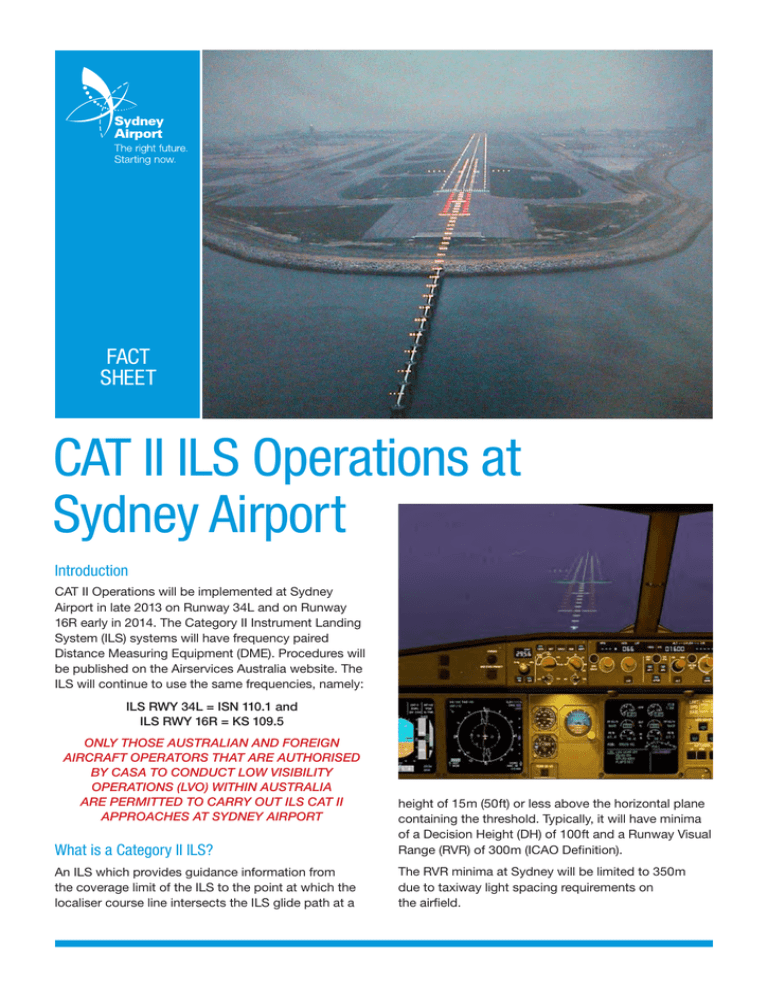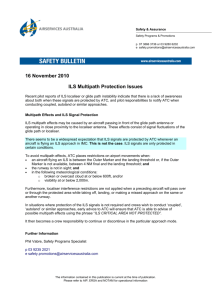CAT II ILS Operations at Sydney Airport
advertisement

FACT SHEET CAT II ILS Operations at Sydney Airport Introduction CAT II Operations will be implemented at Sydney Airport in late 2013 on Runway 34L and on Runway 16R early in 2014. The Category II Instrument Landing System (ILS) systems will have frequency paired Distance Measuring Equipment (DME). Procedures will be published on the Airservices Australia website. The ILS will continue to use the same frequencies, namely: ILS RWY 34L = ISN 110.1 and ILS RWY 16R = KS 109.5 ONLY THOSE AUSTRALIAN AND FOREIGN AIRCRAFT OPERATORS THAT ARE AUTHORISED BY CASA TO CONDUCT LOW VISIBILITY OPERATIONS (LVO) WITHIN AUSTRALIA ARE PERMITTED TO CARRY OUT ILS CAT II APPROACHES AT SYDNEY AIRPORT What is a Category II ILS? height of 15 m (50 ft) or less above the horizontal plane containing the threshold. Typically, it will have minima of a Decision Height (DH) of 100 ft and a Runway Visual Range (RVR) of 300 m (ICAO Definition). An ILS which provides guidance information from the coverage limit of the ILS to the point at which the localiser course line intersects the ILS glide path at a The RVR minima at Sydney will be limited to 350 m due to taxiway light spacing requirements on the airfield. Approach and Runway Lighting Cat II ILS Minima Both ends will ultimately have an ALSF-2 Approach Lighting System with Sequenced Flashing Strobe Lights (“Running Rabbit”). The CAT II ILS will enable lower minima to be used for both Runways 16R and 34L. The minima will be a DH/RVR of 100 ft HAT/350 m for both runways. The minima for ILS CAT I approach for 16R will remain at 210 (202) ft AGL/550 m RVR for RWY 16R, whilst for 34L, it will be 220 (206) ft/800 m RVR [previously 1500 m (VIS)]. This means that all aircraft will benefit and not only those aircraft suitably equipped and with qualified crews to carry out CAT II approaches. Runway 34L Runway 34L will consist of a reduced length High Intensity Approach Lighting System (HIAL). The Runway 34L HIAL will have an ICAO compliant 420 m layout. This is due to the restricted land available prior to the 34L threshold. Beyond this are the waters of Botany Bay. An extensive consultation process and risk assessment has been undertaken with all the key stakeholders, including operators and pilot association representatives, prior to the reduced HIAL array being approved by CASA. A reduced HIAL system of 420 m is already allowed in Europe and such a system is in operation at Barcelona Airport. For a B747 aircraft at 100 ft DH, RVR 350 m, the above segment of the approach lighting system is visible: • White cross-bar with red side barrettes – 150 m from the runway threshold. • Followed by 4 red sidebar barrettes and the corresponding 4 white centreline barrettes (spaced 30 m apart) • Green runway threshold lights. The exact view will, however, depend on the aircraft design eye height and the slant range. For example, in a control seat of the B747-400, sitting at design eye, the flight deck is 43 ft above the Main Gear Height. Therefore, at the 100 ft DH (main gear height), Pilot eye height in a B747 is 143 ft. Pilot eye height ILS G/S antenna height “TCH” Main gear height Runway 16R Runway 16R will have a 900 m lighting array. A Full ALSF II Array at Hong Kong Airport Approach Lighting System (ALS) 420m layout Threshold Lights: appear green for aircraft landing and red for aircraft taking off Approach Light • Warning red light, which a/c should not land yet Cross Bar Light • Indicate a/c wings status Sequence Flashing Light • To guide the pilot’s eyes toward the runway centreline Runway Touch Down Zone Light • Gives depth view of the runway Other Requirements for Upgrading ILS Taxi Routes In order to upgrade from CAT I to CAT II, in addition to a HIALS (including touchdown zone lighting), centreline lighting and a secondary power source for the ILS with an instantaneous switch over time are required. Other requirements are associated with the more stringent monitoring of the ILS signal and protection of both the ILS glideslope and the localiser. This is why we see Pattern B Runway Hold Point used on Taxiway ALPHA which is used to protect the present ILS CAT I Critical Area. Inset stop bars have also been installed at these locations, which are selectively operated by Sydney ATC when the hold points are in use for protection of the ILS (Cloud base less than 600 ft and visibility less than 2000 m). The ILS sensitivity area becomes more critical in CAT II, because generally the aircraft are using auto-land. During low visibility operations Taxiway routes for aircraft other than A380 will remain unchanged. Remember: Never Cross a Red Stop Bar Issued: November 2013 For A380 aircraft, specific taxiway routing can be found in The Sydney Airport Operations Manual. This leaflet is for guidance only. Pilots should ensure that they have reviewed the latest NOTAMS and other information prior to conducting Low Vis Operations at Sydney Airport. Pilots should operate in accordance with the operator’s own SOPs. References [1] ICAO Annex 10 [2] ERSA [3] ICAO Annex 14/MOS 139


